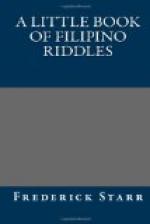“Una arquita muy chiquita tan blanca como la cal todo lo saben abrir pero ninguno cerrar.”
But the metaphor “the King’s limebox” could only occur in a district of betel-chewing and is a native touch. Many of the Filipino riddles introduce the names of saints and, to that degree, evidence foreign influence; but even in such cases there may be local coloring; thus, calling rain-drops falling “rods,” “St. Joseph’s rods cannot be counted,” could hardly be found outside of the tropics. Religious riddles, relating to beads, bells, church, crucifixes, are common enough and are necessarily due to outside influence, but even such sometimes show a non-European attitude of mind, metaphorical expression or form of thought.
Everywhere riddles vary in quality and value. Many are stupid things, crudely conceived and badly expressed. Only the exceptional is fine. Examine any page of one of our own riddle books and you may criticize almost every riddle upon it for view-point, or form, or flavor. We must not demand more from Filipino riddles than from our own. Some knowledge of local products, customs, conditions, is necessary for the understanding of their meaning; when understood, they are fully equal to ours in shrewdness, wit and expression. Krauss emphasizes the fact that everywhere riddles tend to coarseness and even to obscenity and discusses the reasons. What is true elsewhere is true here; a considerable number of Filipino riddles are coarse; we have introduced them but emphasize the fact that any scientifically formed collection of German or English riddles would contain some quite as bad.
Probably few of our readers have considered the taxonomy of riddles. Friedreich offers a loose and unscientific classification as follows:
I. The Question Riddle.
II. The Simple Word
Riddle (with seven sub-divisions).
III. The Syllable Riddle
or Charade.
IV. The Letter Riddle.
1.
With reference to sound.
2.
With reference to form.
V. Punctuation Riddles.
VI. The Rebus.
VII. Complex Riddles;
combination of two or more simple types.
VIII. Number Riddles.
Several of these forms occur in our collection.
More scientific than Friedreich’s work is Petsch’s Studien ueber das Volksraetsel. His analysis and dissection of riddle forms best enable us to test the indigenous content of our Filipino riddles. He recognizes two fundamental riddle types. He says: “Two groups of riddles have long been distinguished in the collections, the true rhymed riddles and the short ‘catch-questions’ expressed in prose. The difference is not only in form but in content. ‘True riddles’ have as purpose the describing of an object in veiled, thought-arousing, perhaps misleading, poetical clothing, which, from this presentation of its appearance, its source, its utility, etc., shall be recognized




